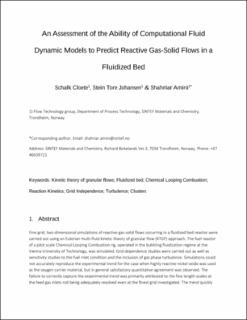| dc.contributor.author | Cloete, Schalk | |
| dc.contributor.author | Johansen, Stein Tore | |
| dc.contributor.author | Amini, Shahriar | |
| dc.date.accessioned | 2020-12-14T11:10:39Z | |
| dc.date.available | 2020-12-14T11:10:39Z | |
| dc.date.created | 2012-01-18T14:50:53Z | |
| dc.date.issued | 2012 | |
| dc.identifier.citation | Powder Technology. 2012, 215-16 15-25. | en_US |
| dc.identifier.issn | 0032-5910 | |
| dc.identifier.uri | https://hdl.handle.net/11250/2719121 | |
| dc.description.abstract | Fine grid, two dimensional simulations of reactive gas–solid flows occurring in a fluidized bed reactor were carried out using the Eulerian multi-fluid kinetic theory of granular flow (KTGF) approach in the commercial flow solver, ANSYS FLUENT 12.1. The fuel reactor of a pilot scale Chemical Looping Combustion rig, operated in the bubbling fluidization regime at the Vienna University of Technology, was simulated. Grid dependence studies were carried out as well as sensitivity studies to the fuel inlet condition and the inclusion of gas phase turbulence. Simulations could not accurately reproduce the experimental trend for the case when highly reactive nickel oxide was used as the oxygen carrier material, but in general satisfactory quantitative agreement was observed. The failure to correctly capture the experimental trend was primarily attributed to the fine length-scales at the feed gas inlets not being adequately resolved even at the finest grid investigated. The trend quickly worsened when coarser grids were used, indicating that the generality of the model is lost when grid dependence effects are present. A number of possible dimensional effects were also discussed. Subsequently, the model was used to successfully capture another experimental trend obtained with a much less reactive ilmenite oxygen carrier material. The model captured this trend correctly because the reaction was now limited by the reaction rate and not by species transfer to the large scale gas-emulsion interfaces. Results were therefore not as sensitive to the correct hydrodynamic modelling of the interface, especially near the gas inlets, and the model retained its generality over a wide range of operating conditions. | en_US |
| dc.language.iso | eng | en_US |
| dc.publisher | Elsevier | en_US |
| dc.rights | Attribution-NonCommercial-NoDerivatives 4.0 Internasjonal | * |
| dc.rights.uri | http://creativecommons.org/licenses/by-nc-nd/4.0/deed.no | * |
| dc.subject | Turbulence | en_US |
| dc.subject | Grid independence | en_US |
| dc.subject | Reaction kinetics | en_US |
| dc.subject | Chemical looping combustion | en_US |
| dc.subject | Fluidized bed | en_US |
| dc.subject | Kinetic theory of granular flows | en_US |
| dc.title | An assessment of the ability of computational fluid dynamic models to predict reactive gas-solid flows in a fluidized bed | en_US |
| dc.type | Peer reviewed | en_US |
| dc.type | Journal article | en_US |
| dc.description.version | acceptedVersion | en_US |
| dc.rights.holder | © 2011. This is the authors’ accepted and refereed manuscript to the article. This manuscript version is made available under the CC-BY-NC-ND 4.0 license http://creativecommons.org/licenses/by-nc-nd/4.0/ | en_US |
| dc.source.pagenumber | 15-25 | en_US |
| dc.source.volume | 215-16 | en_US |
| dc.source.journal | Powder Technology | en_US |
| dc.identifier.doi | 10.1016/j.powtec.2011.08.033 | |
| dc.identifier.cristin | 889254 | |
| dc.relation.project | Norges forskningsråd: 197580 | en_US |
| dc.relation.project | Notur/NorStore: NN9154K | en_US |
| cristin.unitcode | 7401,80,5,2 | |
| cristin.unitname | Strømningsteknikk | |
| cristin.ispublished | true | |
| cristin.fulltext | postprint | |
| cristin.qualitycode | 1 | |

